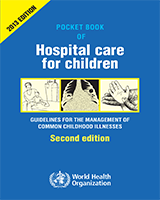All rights reserved. Publications of the World Health Organization are available on the WHO web site (www.who.int) or can be purchased from WHO Press, World Health Organization, 20 Avenue Appia, 1211 Geneva 27, Switzerland (tel.: +41 22 791 3264; fax: +41 22 791 4857; e-mail: tni.ohw@sredrokoob). Requests for permission to reproduce or translate WHO publications – whether for sale or for non-commercial distribution – should be addressed to WHO Press through the WHO web site (www.who.int/about/licensing/copyright_form/en/index.html).
NCBI Bookshelf. A service of the National Library of Medicine, National Institutes of Health.
Overview
This is the second edition of the Pocket book of hospital care for children. It is for use by doctors, nurses and other health workers who are responsible for the care of young children at the first level referral hospitals. The Pocket Book is one of a series of documents and tools that support the Integrated Management of Childhood Illness (IMCI). It is an update of the 2005 edition, and presents up-to-date evidence based clinical guidelines from several recently updated and published WHO guidelines and recommendations. The guidelines are for use in both inpatient and outpatient care in hospitals with basic laboratory facilities and essential medicines. These guidelines focus on the management of the major causes of childhood mortality in most developing countries, such as newborn problems, pneumonia, diarrhoea, malaria, meningitis, septicaemia, measles and related conditions, severe acute malnutrition and paediatric HIV/AIDS. It also covers common procedures, patient monitoring and supportive care on the wards and some common surgical conditions that can be managed in small hospitals.
Details of the evidence on which the Pocket Book is based can be found on the WHO website from the relevant published guidelines provided in the bibliography. This bedside paediatric care guidelines are applicable in most areas of the world and may be adapted to suit country specific circumstances. However, advanced and high care treatment options, such as intensive care or mechanical ventilation, are not described. The Pocket Book is also available in hard copies although the online version will be updated regularly as new evidence emerges.
Contents
- Preface
- Acknowledgements
- Abbreviations
- 1. Triage and emergency conditions
- 1.1 Triage
- 1.2 Summary of steps in emergency triage assessment and treatment
- 1.3 Assessment of emergency and priority signs
- 1.4 Emergency treatment for a child with severe malnutrition
- 1.5 Diagnostic considerations for children with emergency conditions
- 1.6 Common poisoning
- 1.7 Drowning
- 1.8 Electrocution
- 1.9 Common causes of envenoming
- 1.10 Trauma and injuries
- 2. Diagnostic approaches to the sick child
- 3. Problems of the neonate and young infant
- 3.1 Essential newborn care at delivery
- 3.2 Neonatal resuscitation
- 3.3 Routine care for all newborns after delivery
- 3.4 Prevention of neonatal infections
- 3.5 Management of infants with hypoxic ischaemic encephalopathy
- 3.6 Danger signs in newborns and young infants
- 3.7 Convulsions or fits
- 3.8 Serious bacterial infection
- 3.9 Meningitis
- 3.10 Supportive care for sick neonates
- 3.11 Preterm and low-birth-weight infants
- 3.12 Other common neonatal problems
- 3.13 Infants of mothers with infectious diseases
- 3.14 Doses of common drugs for neonates and low-birth-weight infants
- 4. Cough or difficulty in breathing
- 5. Diarrhoea
- 6. Fever
- 7. Severe acute malnutrition
- 8. Children with HIV/AIDS
- 9. Common surgical problems
- 10. Supportive care
- 11. Monitoring the child's progress
- 12. Counselling and discharge from hospital
- Bibliography
- Annexes
- Daily monitoring chart
- Antimicrobial drugs for common conditions
The designations employed and the presentation of the material in this publication do not imply the expression of any opinion whatsoever on the part of the World Health Organization concerning the legal status of any country, territory, city or area or of its authorities, or concerning the delimitation of its frontiers or boundaries. Dotted lines on maps represent approximate border lines for which there may not yet be full agreement.
The mention of specific companies or of certain manufacturers' products does not imply that they are endorsed or recommended by the World Health Organization in preference to others of a similar nature that are not mentioned. Errors and omissions excepted, the names of proprietary products are distinguished by initial capital letters.
All reasonable precautions have been taken by the World Health Organization to verify the information contained in this publication. However, the published material is being distributed without warranty of any kind, either expressed or implied. The responsibility for the interpretation and use of the material lies with the reader. In no event shall the World Health Organization be liable for damages arising from its use.
- NLM CatalogRelated NLM Catalog Entries
- Pocket Book of Hospital Care for ChildrenPocket Book of Hospital Care for Children
Your browsing activity is empty.
Activity recording is turned off.
See more...
